LYMPHANGITIS by Ken Keckler DVM
- posted: Jul. 07, 2014
(As originally published in the summer 2012 OPHA Magazine)
Lymphangitis, vasculitis, big leg disease, Staph infection, cellulitis. Whatever you call it, this recurrent leg infection and swelling affects many horses and is a frustrating cause of lameness and loss of money and time. All of these names can be correct: the suffix –itis means “inflammation”- of the lymphatic system (lymphangitis), blood vessels (vasculitis), or subcutaneous connective tissue (cellulitis).
Many horses will “stock up”, with subcutaneous edema in two or more legs (usually hind limbs). This minor problem frequently is seen in horses that have been stall rested or have a significant decease in exercise. Muscle contraction and elevated blood pressure (e.g. increased heart rate) are the typical forces that move blood and lymph fluid back toward the heart. The equine lower limb has no muscles to contract, and therefore must rely on one-way valves in the vessels to hold the fluids, and compression of the frog to impel it upward. Stocking up usually resolves with exercise.
Lymphangitis (or whatever you’d like to call it) is dramatically different. A horse that was “normal” yesterday presents with a hugely swollen leg (usually a hind leg), extreme pain (“three legged lame”, on its’ toe), and an elevated temperature (from 102-105 degrees F). Frequently these horses will not eat (probably from the fever and discomfort), show obvious depression, and some will be trembling, blowing (breathing rapidly), and sweating. On examination, the limb will have “pitting edema”(when you squeeze, imprints of your fingers will be left in the tissue) and the horse will raise the leg so far up to avoid your touch that they almost fall over. The worst case I ever saw was flat out on her side, with the effected hind leg so swollen from pastern to pelvis that it jutted straight out from her body. She had a 105-degree temperature, and was toxic from the bacterial infection; her gums were brick red. With treatment, she survived, but the leg was never the same.
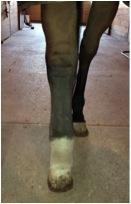
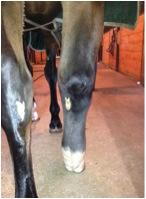
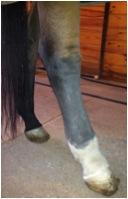
Right hind leg with chronic, active lymphangitis
So why does this occur, and what exactly happens? We’d all like to know! The veterinary community’s best educated guess is that a cut, nick, or even simple abrasion to the leg allows bacteria access. Many times this is Staph aureus, or Strep zooepidemicus, and I have also cultured E. coli. The bacteria reproduces quickly, setting up shop in the tissues, causing the inflammatory reactions of heat and swelling as the body tries to attack the invaders. The lymphatic system drains fluid from the legs, filtering it through lymph nodes that try to remove foreign pathogens. The lymph nodes are overwhelmed, and possibly become infected themselves. Lymph ducts and blood vessels become damaged, swollen, and lose their elasticity, blood and lymph pooling on top of the one-way valves. The heart continues to pump in fluid, but the exits are blocked.
Within a few hours to days, the tightly stretched skin allows fluid to seep through the most damaged areas. This serum is irritating to the epidermis and can scald or dry as clinging, yellow crusts. In some cases, abscesses may develop under the skin as the body tries to wall off the assailants. These can be found on ultrasound, or may develop as an obvious bulge on the limb, and should be lanced and drained.
In an acute episode, aggressive antibiotics and anti-inflammatories are a must. Many times phenylbutasone (Bute) and flunixin meglamine (Banamine) are used for pain, inflammation, and swelling. Cold water/ice may be useful as long as the leg is not left wet - the skin is already compromised. Sometimes I will use intravenous DMSO as an additional anti-inflammatory. The use of corticosteroids (like dexamethasone) is debated among veterinarians. While steroids are very potent anti-inflammatories, they work by suppressing the immune system. I typically use them a few days after the other medications have had time to work.
The most challenging part of treatment is to get the extremely painful horse to move. Movement, as previously discussed, is necessary to help promote fluid to move back up the leg. They have to walk, but will strongly resist. In some instances, an epidural can be given to block the pain so the horse will step.
Affected limbs usually come down in size, but may never return to normal. Recurrent bouts are common and are treated as above. Use of topical ointments/creams with antibacterials and cortisones have been tried with inconsistent results. I have tried immune stimulants and long term use of oral antibiotics, but you never know when the leg will flare up again. Some advocate a massage of the limb to help work the fluid away, which is likely helpful. Bandaging in the acute phase is dangerous, in my opinion, as the swelling continues above whatever wrap is applied. Compressive leg wraps or stockings may help “bring the leg down” between attacks.
Dark, horny, almost wart-like growths tend to develop on pasterns and fetlocks of chronically afflicted horses. These are very painful to the horse when peeled away, and will bleed significantly. Frequently these are mistaken for “mud fever”. Long term, the leg may remain enlarged and be chronically “stiff” as it’s uncomfortable to bend a swollen leg. Thickened folds on the back of the pastern and scarred skin can develop. Hoof growth may be affected, as the coronet band is usually compromised by abnormal blood flow, and appears constricted compared to the “fat” pastern.
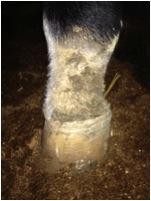
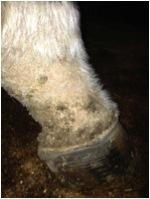
Chronic lymphangitis with skin proliferation- “horny growths”
For the chronically affected, routine exercise and close observation are required. Early detection when the leg begins to swell may improve the outcome. Lymphangitis is an aggravating, insidious problem that seriously damages a horse’s athletic career, and frustrating for owners and veterinarians to treat.
Location
Find us on the map
16295 Claridon Troy Road
Burton, OH 44021, US
Office Hours
24 Hour Emergency Care - 365 Days a Year
8:00 am - 4:30 pm
8:00 am - 4:30 pm
8:00 am - 4:30 pm
8:00 am - 4:30 pm
8:00 am - 4:30 pm
Emergencies Only
Emergencies Only

